Conflict Management Strategy for Scottish Parliament Project Report
VerifiedAdded on 2021/01/02
|12
|4026
|348
Report
AI Summary
This report analyzes the conflict management strategies applicable to the Scottish Parliament Project, focusing on the conflicts between Mr. Armstrong (Project Manager) and Mrs. Doig (Project Sponsor). It delves into the Jameson model, highlighting interest-based, rights-based, and power-based negotiation strategies. The report emphasizes the importance of communication, including verbal and non-verbal cues, preparation, and open-ended communication, for effective conflict resolution. It explores communication implications, such as the use of various communication channels and power dynamics, and advocates for integrative negotiation to achieve win-win solutions. The report stresses the significance of understanding interests, needs, and the potential benefits of fostering positive relationships to manage conflicts effectively within the project.
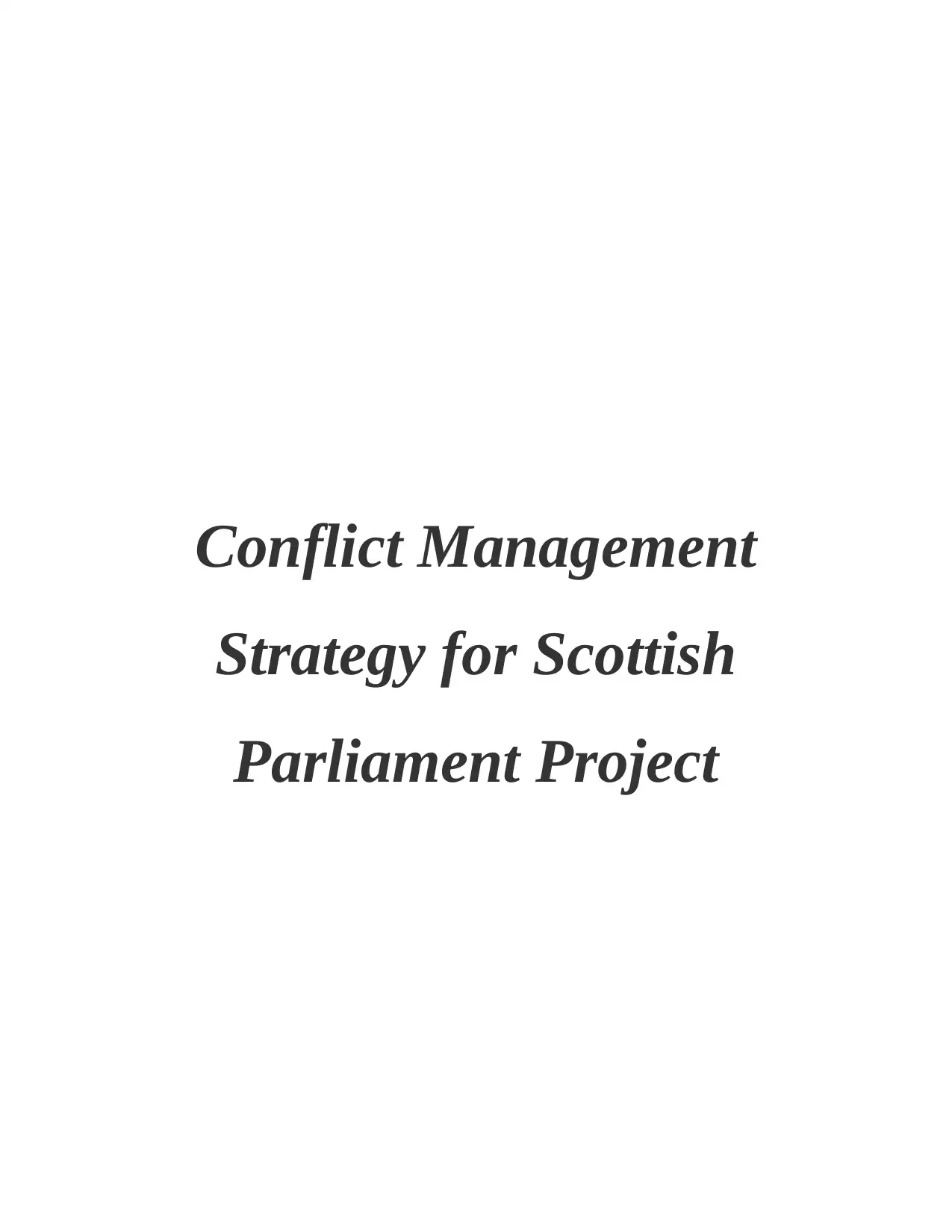
Conflict Management
Strategy for Scottish
Parliament Project
Strategy for Scottish
Parliament Project
Paraphrase This Document
Need a fresh take? Get an instant paraphrase of this document with our AI Paraphraser
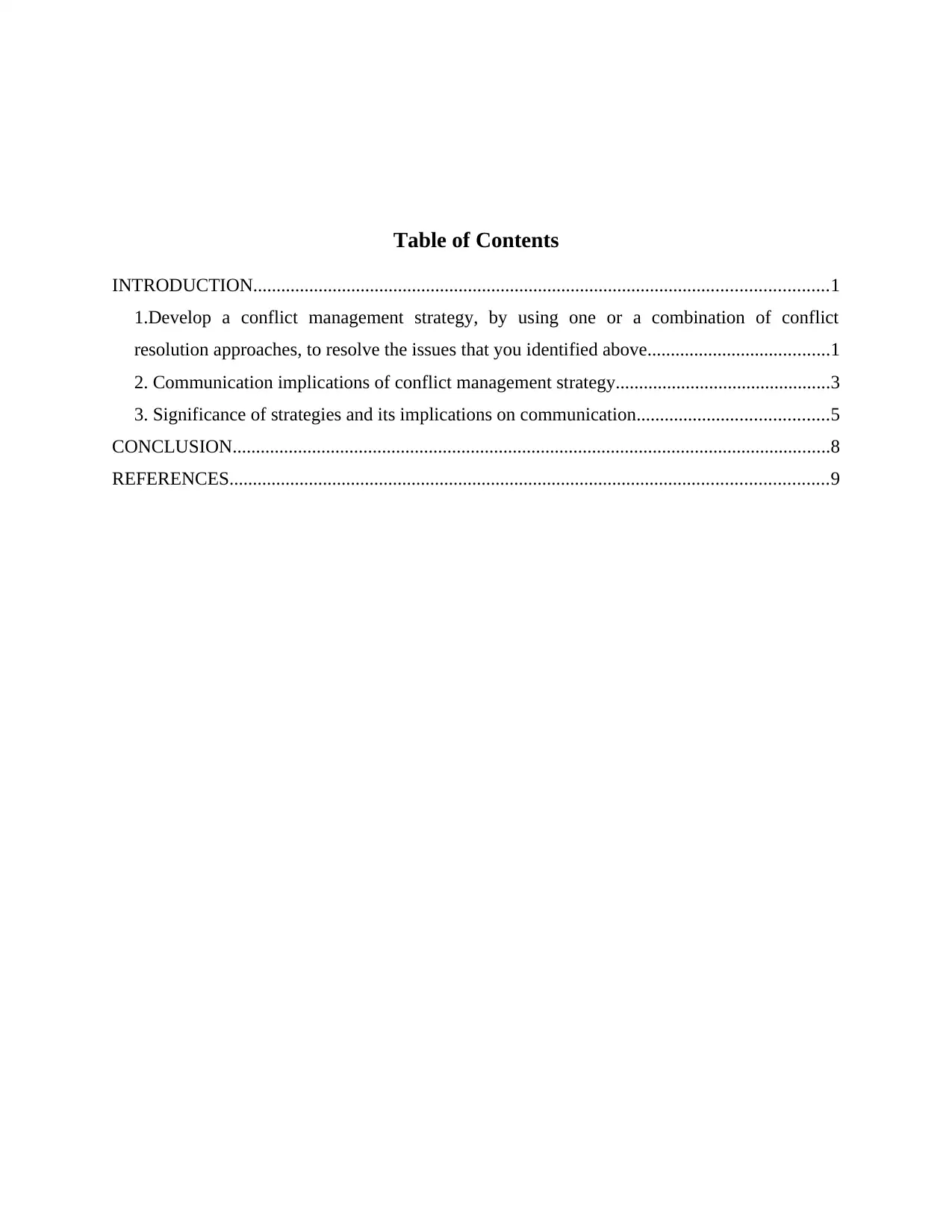
Table of Contents
INTRODUCTION...........................................................................................................................1
1.Develop a conflict management strategy, by using one or a combination of conflict
resolution approaches, to resolve the issues that you identified above.......................................1
2. Communication implications of conflict management strategy..............................................3
3. Significance of strategies and its implications on communication.........................................5
CONCLUSION................................................................................................................................8
REFERENCES................................................................................................................................9
INTRODUCTION...........................................................................................................................1
1.Develop a conflict management strategy, by using one or a combination of conflict
resolution approaches, to resolve the issues that you identified above.......................................1
2. Communication implications of conflict management strategy..............................................3
3. Significance of strategies and its implications on communication.........................................5
CONCLUSION................................................................................................................................8
REFERENCES................................................................................................................................9
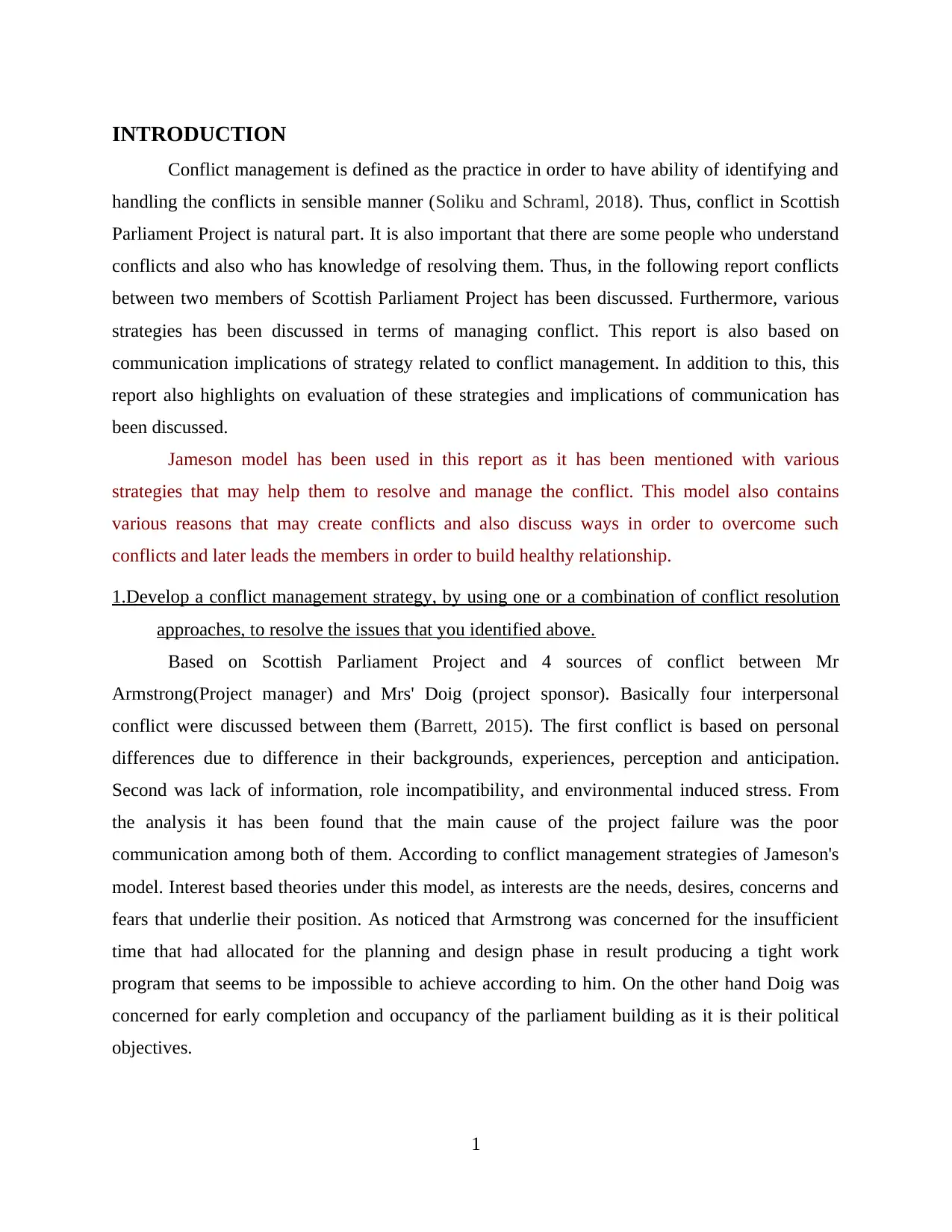
INTRODUCTION
Conflict management is defined as the practice in order to have ability of identifying and
handling the conflicts in sensible manner (Soliku and Schraml, 2018). Thus, conflict in Scottish
Parliament Project is natural part. It is also important that there are some people who understand
conflicts and also who has knowledge of resolving them. Thus, in the following report conflicts
between two members of Scottish Parliament Project has been discussed. Furthermore, various
strategies has been discussed in terms of managing conflict. This report is also based on
communication implications of strategy related to conflict management. In addition to this, this
report also highlights on evaluation of these strategies and implications of communication has
been discussed.
Jameson model has been used in this report as it has been mentioned with various
strategies that may help them to resolve and manage the conflict. This model also contains
various reasons that may create conflicts and also discuss ways in order to overcome such
conflicts and later leads the members in order to build healthy relationship.
1.Develop a conflict management strategy, by using one or a combination of conflict resolution
approaches, to resolve the issues that you identified above.
Based on Scottish Parliament Project and 4 sources of conflict between Mr
Armstrong(Project manager) and Mrs' Doig (project sponsor). Basically four interpersonal
conflict were discussed between them (Barrett, 2015). The first conflict is based on personal
differences due to difference in their backgrounds, experiences, perception and anticipation.
Second was lack of information, role incompatibility, and environmental induced stress. From
the analysis it has been found that the main cause of the project failure was the poor
communication among both of them. According to conflict management strategies of Jameson's
model. Interest based theories under this model, as interests are the needs, desires, concerns and
fears that underlie their position. As noticed that Armstrong was concerned for the insufficient
time that had allocated for the planning and design phase in result producing a tight work
program that seems to be impossible to achieve according to him. On the other hand Doig was
concerned for early completion and occupancy of the parliament building as it is their political
objectives.
1
Conflict management is defined as the practice in order to have ability of identifying and
handling the conflicts in sensible manner (Soliku and Schraml, 2018). Thus, conflict in Scottish
Parliament Project is natural part. It is also important that there are some people who understand
conflicts and also who has knowledge of resolving them. Thus, in the following report conflicts
between two members of Scottish Parliament Project has been discussed. Furthermore, various
strategies has been discussed in terms of managing conflict. This report is also based on
communication implications of strategy related to conflict management. In addition to this, this
report also highlights on evaluation of these strategies and implications of communication has
been discussed.
Jameson model has been used in this report as it has been mentioned with various
strategies that may help them to resolve and manage the conflict. This model also contains
various reasons that may create conflicts and also discuss ways in order to overcome such
conflicts and later leads the members in order to build healthy relationship.
1.Develop a conflict management strategy, by using one or a combination of conflict resolution
approaches, to resolve the issues that you identified above.
Based on Scottish Parliament Project and 4 sources of conflict between Mr
Armstrong(Project manager) and Mrs' Doig (project sponsor). Basically four interpersonal
conflict were discussed between them (Barrett, 2015). The first conflict is based on personal
differences due to difference in their backgrounds, experiences, perception and anticipation.
Second was lack of information, role incompatibility, and environmental induced stress. From
the analysis it has been found that the main cause of the project failure was the poor
communication among both of them. According to conflict management strategies of Jameson's
model. Interest based theories under this model, as interests are the needs, desires, concerns and
fears that underlie their position. As noticed that Armstrong was concerned for the insufficient
time that had allocated for the planning and design phase in result producing a tight work
program that seems to be impossible to achieve according to him. On the other hand Doig was
concerned for early completion and occupancy of the parliament building as it is their political
objectives.
1
⊘ This is a preview!⊘
Do you want full access?
Subscribe today to unlock all pages.

Trusted by 1+ million students worldwide
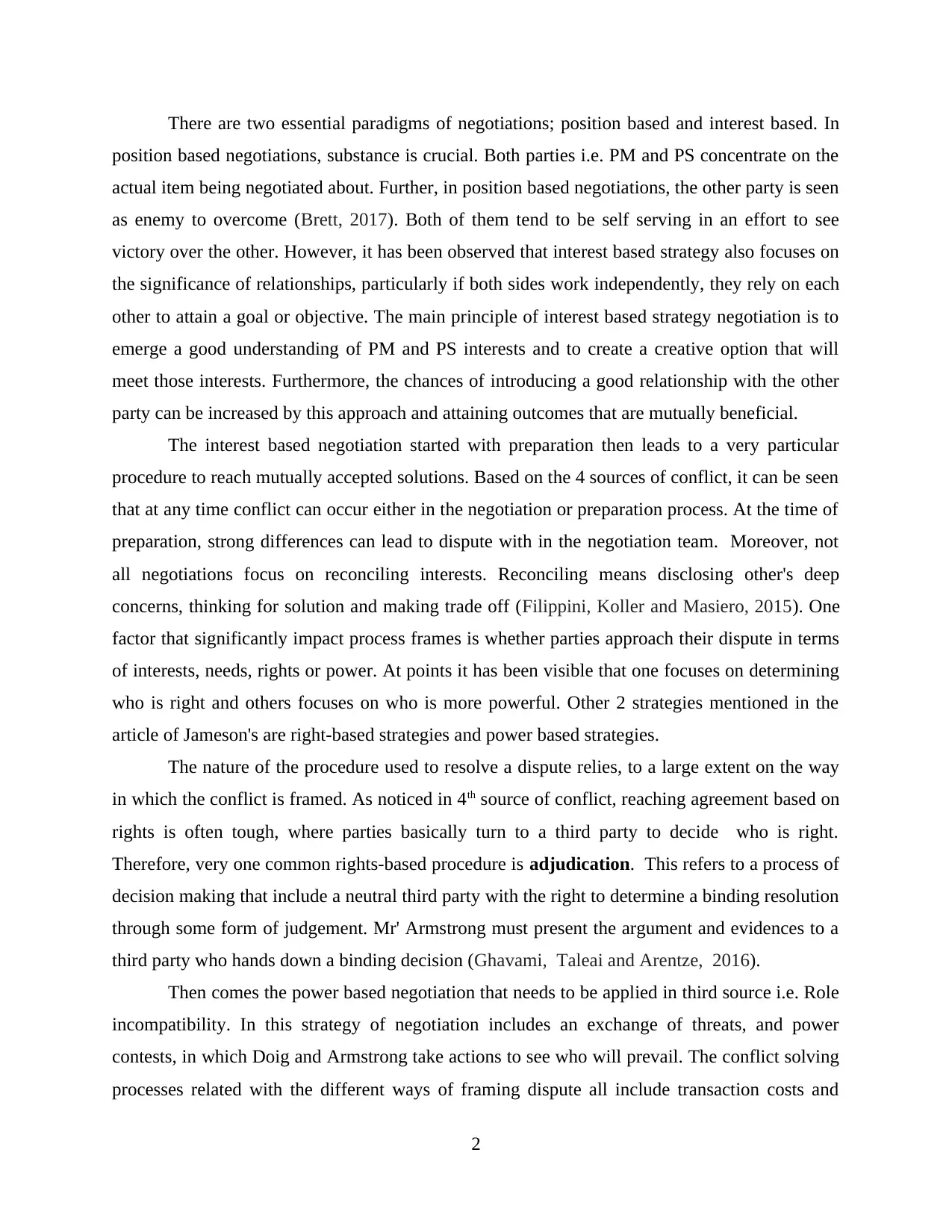
There are two essential paradigms of negotiations; position based and interest based. In
position based negotiations, substance is crucial. Both parties i.e. PM and PS concentrate on the
actual item being negotiated about. Further, in position based negotiations, the other party is seen
as enemy to overcome (Brett, 2017). Both of them tend to be self serving in an effort to see
victory over the other. However, it has been observed that interest based strategy also focuses on
the significance of relationships, particularly if both sides work independently, they rely on each
other to attain a goal or objective. The main principle of interest based strategy negotiation is to
emerge a good understanding of PM and PS interests and to create a creative option that will
meet those interests. Furthermore, the chances of introducing a good relationship with the other
party can be increased by this approach and attaining outcomes that are mutually beneficial.
The interest based negotiation started with preparation then leads to a very particular
procedure to reach mutually accepted solutions. Based on the 4 sources of conflict, it can be seen
that at any time conflict can occur either in the negotiation or preparation process. At the time of
preparation, strong differences can lead to dispute with in the negotiation team. Moreover, not
all negotiations focus on reconciling interests. Reconciling means disclosing other's deep
concerns, thinking for solution and making trade off (Filippini, Koller and Masiero, 2015). One
factor that significantly impact process frames is whether parties approach their dispute in terms
of interests, needs, rights or power. At points it has been visible that one focuses on determining
who is right and others focuses on who is more powerful. Other 2 strategies mentioned in the
article of Jameson's are right-based strategies and power based strategies.
The nature of the procedure used to resolve a dispute relies, to a large extent on the way
in which the conflict is framed. As noticed in 4th source of conflict, reaching agreement based on
rights is often tough, where parties basically turn to a third party to decide who is right.
Therefore, very one common rights-based procedure is adjudication. This refers to a process of
decision making that include a neutral third party with the right to determine a binding resolution
through some form of judgement. Mr' Armstrong must present the argument and evidences to a
third party who hands down a binding decision (Ghavami, Taleai and Arentze, 2016).
Then comes the power based negotiation that needs to be applied in third source i.e. Role
incompatibility. In this strategy of negotiation includes an exchange of threats, and power
contests, in which Doig and Armstrong take actions to see who will prevail. The conflict solving
processes related with the different ways of framing dispute all include transaction costs and
2
position based negotiations, substance is crucial. Both parties i.e. PM and PS concentrate on the
actual item being negotiated about. Further, in position based negotiations, the other party is seen
as enemy to overcome (Brett, 2017). Both of them tend to be self serving in an effort to see
victory over the other. However, it has been observed that interest based strategy also focuses on
the significance of relationships, particularly if both sides work independently, they rely on each
other to attain a goal or objective. The main principle of interest based strategy negotiation is to
emerge a good understanding of PM and PS interests and to create a creative option that will
meet those interests. Furthermore, the chances of introducing a good relationship with the other
party can be increased by this approach and attaining outcomes that are mutually beneficial.
The interest based negotiation started with preparation then leads to a very particular
procedure to reach mutually accepted solutions. Based on the 4 sources of conflict, it can be seen
that at any time conflict can occur either in the negotiation or preparation process. At the time of
preparation, strong differences can lead to dispute with in the negotiation team. Moreover, not
all negotiations focus on reconciling interests. Reconciling means disclosing other's deep
concerns, thinking for solution and making trade off (Filippini, Koller and Masiero, 2015). One
factor that significantly impact process frames is whether parties approach their dispute in terms
of interests, needs, rights or power. At points it has been visible that one focuses on determining
who is right and others focuses on who is more powerful. Other 2 strategies mentioned in the
article of Jameson's are right-based strategies and power based strategies.
The nature of the procedure used to resolve a dispute relies, to a large extent on the way
in which the conflict is framed. As noticed in 4th source of conflict, reaching agreement based on
rights is often tough, where parties basically turn to a third party to decide who is right.
Therefore, very one common rights-based procedure is adjudication. This refers to a process of
decision making that include a neutral third party with the right to determine a binding resolution
through some form of judgement. Mr' Armstrong must present the argument and evidences to a
third party who hands down a binding decision (Ghavami, Taleai and Arentze, 2016).
Then comes the power based negotiation that needs to be applied in third source i.e. Role
incompatibility. In this strategy of negotiation includes an exchange of threats, and power
contests, in which Doig and Armstrong take actions to see who will prevail. The conflict solving
processes related with the different ways of framing dispute all include transaction costs and
2
Paraphrase This Document
Need a fresh take? Get an instant paraphrase of this document with our AI Paraphraser
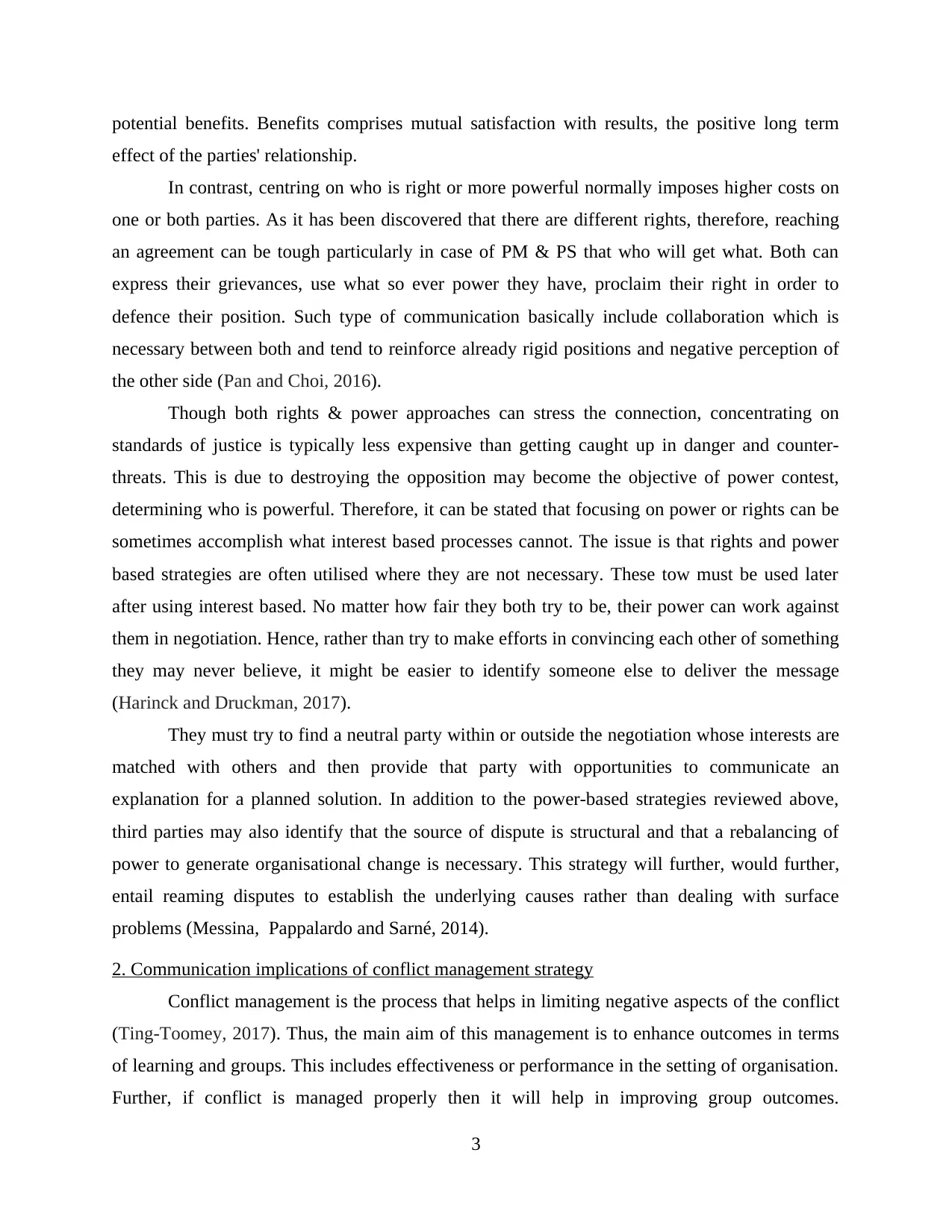
potential benefits. Benefits comprises mutual satisfaction with results, the positive long term
effect of the parties' relationship.
In contrast, centring on who is right or more powerful normally imposes higher costs on
one or both parties. As it has been discovered that there are different rights, therefore, reaching
an agreement can be tough particularly in case of PM & PS that who will get what. Both can
express their grievances, use what so ever power they have, proclaim their right in order to
defence their position. Such type of communication basically include collaboration which is
necessary between both and tend to reinforce already rigid positions and negative perception of
the other side (Pan and Choi, 2016).
Though both rights & power approaches can stress the connection, concentrating on
standards of justice is typically less expensive than getting caught up in danger and counter-
threats. This is due to destroying the opposition may become the objective of power contest,
determining who is powerful. Therefore, it can be stated that focusing on power or rights can be
sometimes accomplish what interest based processes cannot. The issue is that rights and power
based strategies are often utilised where they are not necessary. These tow must be used later
after using interest based. No matter how fair they both try to be, their power can work against
them in negotiation. Hence, rather than try to make efforts in convincing each other of something
they may never believe, it might be easier to identify someone else to deliver the message
(Harinck and Druckman, 2017).
They must try to find a neutral party within or outside the negotiation whose interests are
matched with others and then provide that party with opportunities to communicate an
explanation for a planned solution. In addition to the power-based strategies reviewed above,
third parties may also identify that the source of dispute is structural and that a rebalancing of
power to generate organisational change is necessary. This strategy will further, would further,
entail reaming disputes to establish the underlying causes rather than dealing with surface
problems (Messina, Pappalardo and Sarné, 2014).
2. Communication implications of conflict management strategy
Conflict management is the process that helps in limiting negative aspects of the conflict
(Ting‐Toomey, 2017). Thus, the main aim of this management is to enhance outcomes in terms
of learning and groups. This includes effectiveness or performance in the setting of organisation.
Further, if conflict is managed properly then it will help in improving group outcomes.
3
effect of the parties' relationship.
In contrast, centring on who is right or more powerful normally imposes higher costs on
one or both parties. As it has been discovered that there are different rights, therefore, reaching
an agreement can be tough particularly in case of PM & PS that who will get what. Both can
express their grievances, use what so ever power they have, proclaim their right in order to
defence their position. Such type of communication basically include collaboration which is
necessary between both and tend to reinforce already rigid positions and negative perception of
the other side (Pan and Choi, 2016).
Though both rights & power approaches can stress the connection, concentrating on
standards of justice is typically less expensive than getting caught up in danger and counter-
threats. This is due to destroying the opposition may become the objective of power contest,
determining who is powerful. Therefore, it can be stated that focusing on power or rights can be
sometimes accomplish what interest based processes cannot. The issue is that rights and power
based strategies are often utilised where they are not necessary. These tow must be used later
after using interest based. No matter how fair they both try to be, their power can work against
them in negotiation. Hence, rather than try to make efforts in convincing each other of something
they may never believe, it might be easier to identify someone else to deliver the message
(Harinck and Druckman, 2017).
They must try to find a neutral party within or outside the negotiation whose interests are
matched with others and then provide that party with opportunities to communicate an
explanation for a planned solution. In addition to the power-based strategies reviewed above,
third parties may also identify that the source of dispute is structural and that a rebalancing of
power to generate organisational change is necessary. This strategy will further, would further,
entail reaming disputes to establish the underlying causes rather than dealing with surface
problems (Messina, Pappalardo and Sarné, 2014).
2. Communication implications of conflict management strategy
Conflict management is the process that helps in limiting negative aspects of the conflict
(Ting‐Toomey, 2017). Thus, the main aim of this management is to enhance outcomes in terms
of learning and groups. This includes effectiveness or performance in the setting of organisation.
Further, if conflict is managed properly then it will help in improving group outcomes.
3
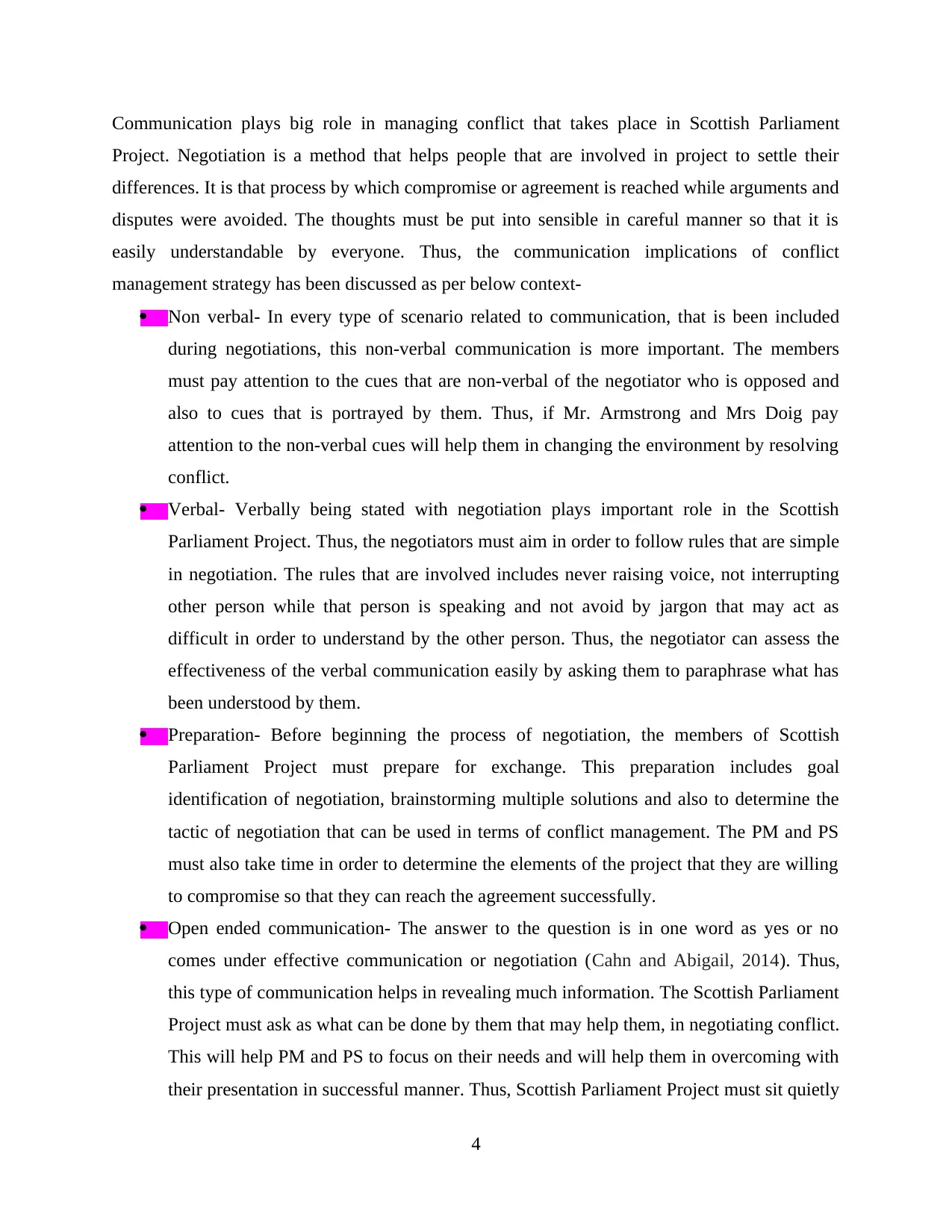
Communication plays big role in managing conflict that takes place in Scottish Parliament
Project. Negotiation is a method that helps people that are involved in project to settle their
differences. It is that process by which compromise or agreement is reached while arguments and
disputes were avoided. The thoughts must be put into sensible in careful manner so that it is
easily understandable by everyone. Thus, the communication implications of conflict
management strategy has been discussed as per below context-
Non verbal- In every type of scenario related to communication, that is been included
during negotiations, this non-verbal communication is more important. The members
must pay attention to the cues that are non-verbal of the negotiator who is opposed and
also to cues that is portrayed by them. Thus, if Mr. Armstrong and Mrs Doig pay
attention to the non-verbal cues will help them in changing the environment by resolving
conflict.
Verbal- Verbally being stated with negotiation plays important role in the Scottish
Parliament Project. Thus, the negotiators must aim in order to follow rules that are simple
in negotiation. The rules that are involved includes never raising voice, not interrupting
other person while that person is speaking and not avoid by jargon that may act as
difficult in order to understand by the other person. Thus, the negotiator can assess the
effectiveness of the verbal communication easily by asking them to paraphrase what has
been understood by them.
Preparation- Before beginning the process of negotiation, the members of Scottish
Parliament Project must prepare for exchange. This preparation includes goal
identification of negotiation, brainstorming multiple solutions and also to determine the
tactic of negotiation that can be used in terms of conflict management. The PM and PS
must also take time in order to determine the elements of the project that they are willing
to compromise so that they can reach the agreement successfully.
Open ended communication- The answer to the question is in one word as yes or no
comes under effective communication or negotiation (Cahn and Abigail, 2014). Thus,
this type of communication helps in revealing much information. The Scottish Parliament
Project must ask as what can be done by them that may help them, in negotiating conflict.
This will help PM and PS to focus on their needs and will help them in overcoming with
their presentation in successful manner. Thus, Scottish Parliament Project must sit quietly
4
Project. Negotiation is a method that helps people that are involved in project to settle their
differences. It is that process by which compromise or agreement is reached while arguments and
disputes were avoided. The thoughts must be put into sensible in careful manner so that it is
easily understandable by everyone. Thus, the communication implications of conflict
management strategy has been discussed as per below context-
Non verbal- In every type of scenario related to communication, that is been included
during negotiations, this non-verbal communication is more important. The members
must pay attention to the cues that are non-verbal of the negotiator who is opposed and
also to cues that is portrayed by them. Thus, if Mr. Armstrong and Mrs Doig pay
attention to the non-verbal cues will help them in changing the environment by resolving
conflict.
Verbal- Verbally being stated with negotiation plays important role in the Scottish
Parliament Project. Thus, the negotiators must aim in order to follow rules that are simple
in negotiation. The rules that are involved includes never raising voice, not interrupting
other person while that person is speaking and not avoid by jargon that may act as
difficult in order to understand by the other person. Thus, the negotiator can assess the
effectiveness of the verbal communication easily by asking them to paraphrase what has
been understood by them.
Preparation- Before beginning the process of negotiation, the members of Scottish
Parliament Project must prepare for exchange. This preparation includes goal
identification of negotiation, brainstorming multiple solutions and also to determine the
tactic of negotiation that can be used in terms of conflict management. The PM and PS
must also take time in order to determine the elements of the project that they are willing
to compromise so that they can reach the agreement successfully.
Open ended communication- The answer to the question is in one word as yes or no
comes under effective communication or negotiation (Cahn and Abigail, 2014). Thus,
this type of communication helps in revealing much information. The Scottish Parliament
Project must ask as what can be done by them that may help them, in negotiating conflict.
This will help PM and PS to focus on their needs and will help them in overcoming with
their presentation in successful manner. Thus, Scottish Parliament Project must sit quietly
4
⊘ This is a preview!⊘
Do you want full access?
Subscribe today to unlock all pages.

Trusted by 1+ million students worldwide
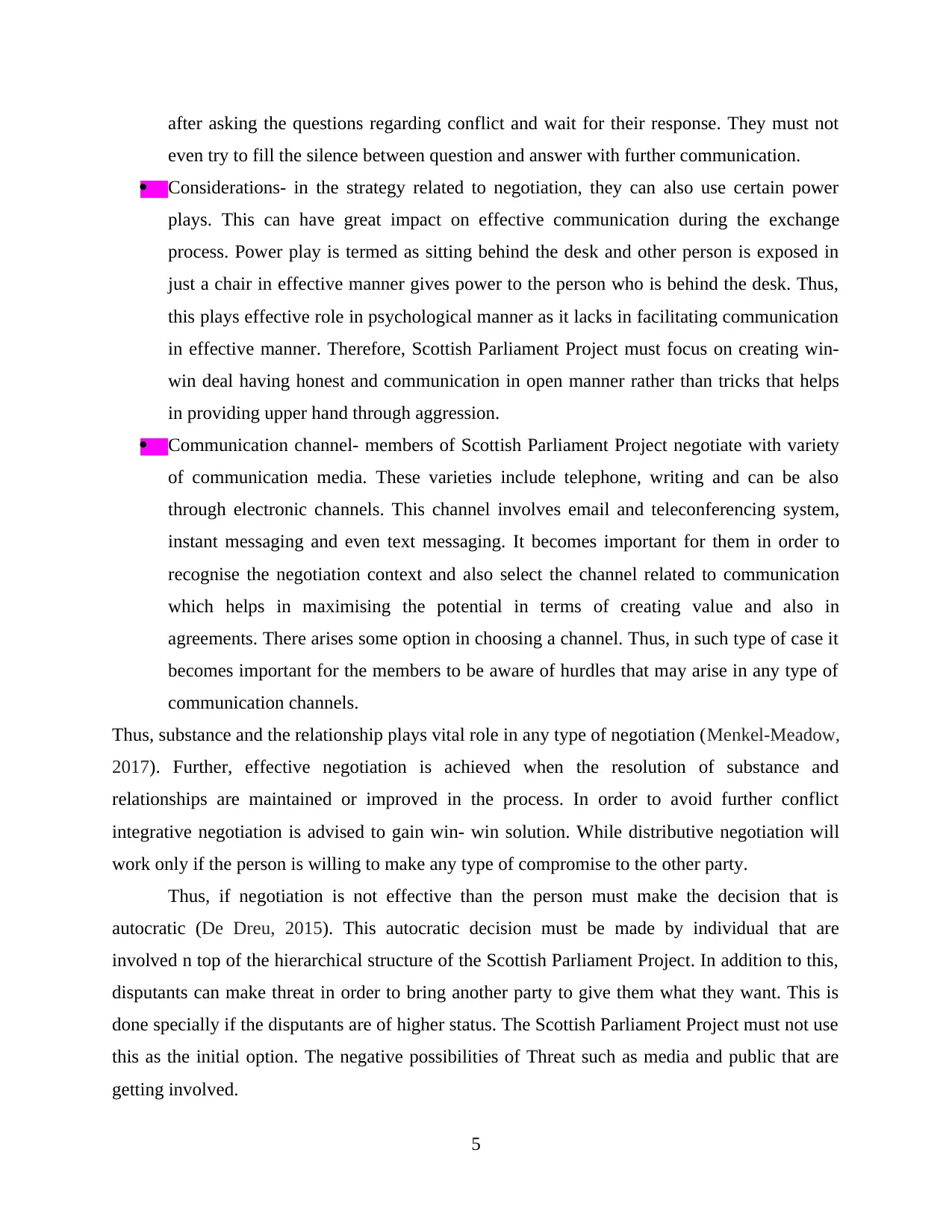
after asking the questions regarding conflict and wait for their response. They must not
even try to fill the silence between question and answer with further communication.
Considerations- in the strategy related to negotiation, they can also use certain power
plays. This can have great impact on effective communication during the exchange
process. Power play is termed as sitting behind the desk and other person is exposed in
just a chair in effective manner gives power to the person who is behind the desk. Thus,
this plays effective role in psychological manner as it lacks in facilitating communication
in effective manner. Therefore, Scottish Parliament Project must focus on creating win-
win deal having honest and communication in open manner rather than tricks that helps
in providing upper hand through aggression.
Communication channel- members of Scottish Parliament Project negotiate with variety
of communication media. These varieties include telephone, writing and can be also
through electronic channels. This channel involves email and teleconferencing system,
instant messaging and even text messaging. It becomes important for them in order to
recognise the negotiation context and also select the channel related to communication
which helps in maximising the potential in terms of creating value and also in
agreements. There arises some option in choosing a channel. Thus, in such type of case it
becomes important for the members to be aware of hurdles that may arise in any type of
communication channels.
Thus, substance and the relationship plays vital role in any type of negotiation (Menkel-Meadow,
2017). Further, effective negotiation is achieved when the resolution of substance and
relationships are maintained or improved in the process. In order to avoid further conflict
integrative negotiation is advised to gain win- win solution. While distributive negotiation will
work only if the person is willing to make any type of compromise to the other party.
Thus, if negotiation is not effective than the person must make the decision that is
autocratic (De Dreu, 2015). This autocratic decision must be made by individual that are
involved n top of the hierarchical structure of the Scottish Parliament Project. In addition to this,
disputants can make threat in order to bring another party to give them what they want. This is
done specially if the disputants are of higher status. The Scottish Parliament Project must not use
this as the initial option. The negative possibilities of Threat such as media and public that are
getting involved.
5
even try to fill the silence between question and answer with further communication.
Considerations- in the strategy related to negotiation, they can also use certain power
plays. This can have great impact on effective communication during the exchange
process. Power play is termed as sitting behind the desk and other person is exposed in
just a chair in effective manner gives power to the person who is behind the desk. Thus,
this plays effective role in psychological manner as it lacks in facilitating communication
in effective manner. Therefore, Scottish Parliament Project must focus on creating win-
win deal having honest and communication in open manner rather than tricks that helps
in providing upper hand through aggression.
Communication channel- members of Scottish Parliament Project negotiate with variety
of communication media. These varieties include telephone, writing and can be also
through electronic channels. This channel involves email and teleconferencing system,
instant messaging and even text messaging. It becomes important for them in order to
recognise the negotiation context and also select the channel related to communication
which helps in maximising the potential in terms of creating value and also in
agreements. There arises some option in choosing a channel. Thus, in such type of case it
becomes important for the members to be aware of hurdles that may arise in any type of
communication channels.
Thus, substance and the relationship plays vital role in any type of negotiation (Menkel-Meadow,
2017). Further, effective negotiation is achieved when the resolution of substance and
relationships are maintained or improved in the process. In order to avoid further conflict
integrative negotiation is advised to gain win- win solution. While distributive negotiation will
work only if the person is willing to make any type of compromise to the other party.
Thus, if negotiation is not effective than the person must make the decision that is
autocratic (De Dreu, 2015). This autocratic decision must be made by individual that are
involved n top of the hierarchical structure of the Scottish Parliament Project. In addition to this,
disputants can make threat in order to bring another party to give them what they want. This is
done specially if the disputants are of higher status. The Scottish Parliament Project must not use
this as the initial option. The negative possibilities of Threat such as media and public that are
getting involved.
5
Paraphrase This Document
Need a fresh take? Get an instant paraphrase of this document with our AI Paraphraser
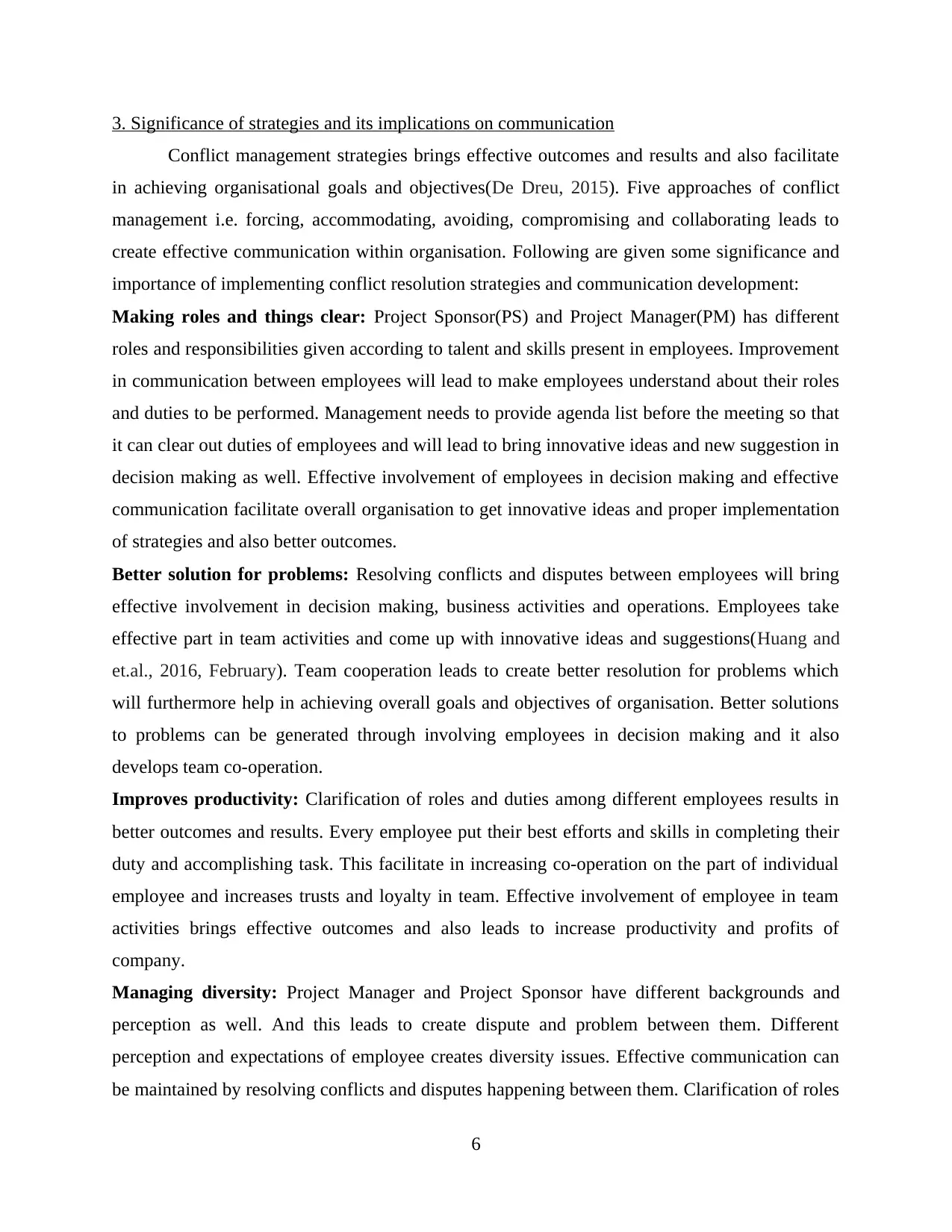
3. Significance of strategies and its implications on communication
Conflict management strategies brings effective outcomes and results and also facilitate
in achieving organisational goals and objectives(De Dreu, 2015). Five approaches of conflict
management i.e. forcing, accommodating, avoiding, compromising and collaborating leads to
create effective communication within organisation. Following are given some significance and
importance of implementing conflict resolution strategies and communication development:
Making roles and things clear: Project Sponsor(PS) and Project Manager(PM) has different
roles and responsibilities given according to talent and skills present in employees. Improvement
in communication between employees will lead to make employees understand about their roles
and duties to be performed. Management needs to provide agenda list before the meeting so that
it can clear out duties of employees and will lead to bring innovative ideas and new suggestion in
decision making as well. Effective involvement of employees in decision making and effective
communication facilitate overall organisation to get innovative ideas and proper implementation
of strategies and also better outcomes.
Better solution for problems: Resolving conflicts and disputes between employees will bring
effective involvement in decision making, business activities and operations. Employees take
effective part in team activities and come up with innovative ideas and suggestions(Huang and
et.al., 2016, February). Team cooperation leads to create better resolution for problems which
will furthermore help in achieving overall goals and objectives of organisation. Better solutions
to problems can be generated through involving employees in decision making and it also
develops team co-operation.
Improves productivity: Clarification of roles and duties among different employees results in
better outcomes and results. Every employee put their best efforts and skills in completing their
duty and accomplishing task. This facilitate in increasing co-operation on the part of individual
employee and increases trusts and loyalty in team. Effective involvement of employee in team
activities brings effective outcomes and also leads to increase productivity and profits of
company.
Managing diversity: Project Manager and Project Sponsor have different backgrounds and
perception as well. And this leads to create dispute and problem between them. Different
perception and expectations of employee creates diversity issues. Effective communication can
be maintained by resolving conflicts and disputes happening between them. Clarification of roles
6
Conflict management strategies brings effective outcomes and results and also facilitate
in achieving organisational goals and objectives(De Dreu, 2015). Five approaches of conflict
management i.e. forcing, accommodating, avoiding, compromising and collaborating leads to
create effective communication within organisation. Following are given some significance and
importance of implementing conflict resolution strategies and communication development:
Making roles and things clear: Project Sponsor(PS) and Project Manager(PM) has different
roles and responsibilities given according to talent and skills present in employees. Improvement
in communication between employees will lead to make employees understand about their roles
and duties to be performed. Management needs to provide agenda list before the meeting so that
it can clear out duties of employees and will lead to bring innovative ideas and new suggestion in
decision making as well. Effective involvement of employees in decision making and effective
communication facilitate overall organisation to get innovative ideas and proper implementation
of strategies and also better outcomes.
Better solution for problems: Resolving conflicts and disputes between employees will bring
effective involvement in decision making, business activities and operations. Employees take
effective part in team activities and come up with innovative ideas and suggestions(Huang and
et.al., 2016, February). Team cooperation leads to create better resolution for problems which
will furthermore help in achieving overall goals and objectives of organisation. Better solutions
to problems can be generated through involving employees in decision making and it also
develops team co-operation.
Improves productivity: Clarification of roles and duties among different employees results in
better outcomes and results. Every employee put their best efforts and skills in completing their
duty and accomplishing task. This facilitate in increasing co-operation on the part of individual
employee and increases trusts and loyalty in team. Effective involvement of employee in team
activities brings effective outcomes and also leads to increase productivity and profits of
company.
Managing diversity: Project Manager and Project Sponsor have different backgrounds and
perception as well. And this leads to create dispute and problem between them. Different
perception and expectations of employee creates diversity issues. Effective communication can
be maintained by resolving conflicts and disputes happening between them. Clarification of roles
6
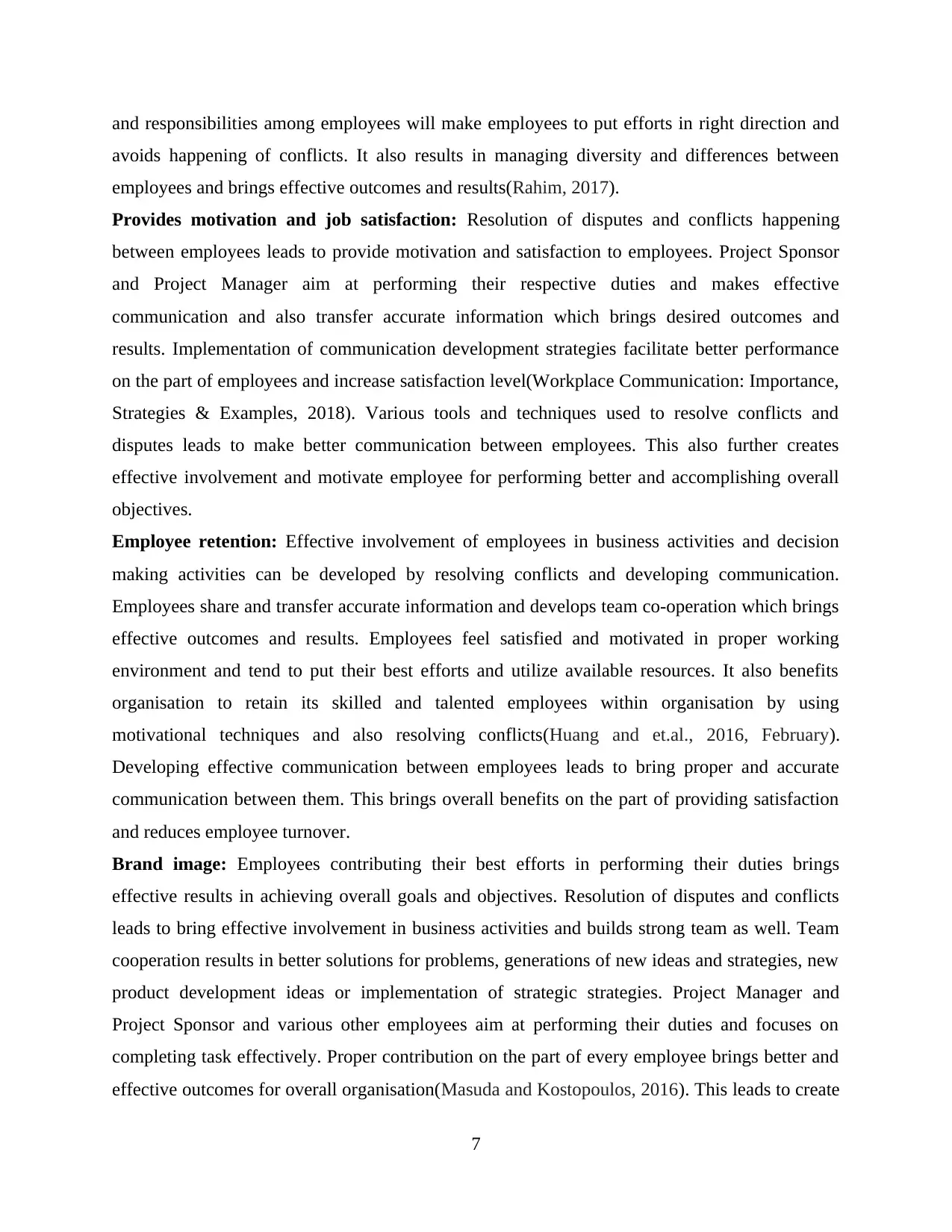
and responsibilities among employees will make employees to put efforts in right direction and
avoids happening of conflicts. It also results in managing diversity and differences between
employees and brings effective outcomes and results(Rahim, 2017).
Provides motivation and job satisfaction: Resolution of disputes and conflicts happening
between employees leads to provide motivation and satisfaction to employees. Project Sponsor
and Project Manager aim at performing their respective duties and makes effective
communication and also transfer accurate information which brings desired outcomes and
results. Implementation of communication development strategies facilitate better performance
on the part of employees and increase satisfaction level(Workplace Communication: Importance,
Strategies & Examples, 2018). Various tools and techniques used to resolve conflicts and
disputes leads to make better communication between employees. This also further creates
effective involvement and motivate employee for performing better and accomplishing overall
objectives.
Employee retention: Effective involvement of employees in business activities and decision
making activities can be developed by resolving conflicts and developing communication.
Employees share and transfer accurate information and develops team co-operation which brings
effective outcomes and results. Employees feel satisfied and motivated in proper working
environment and tend to put their best efforts and utilize available resources. It also benefits
organisation to retain its skilled and talented employees within organisation by using
motivational techniques and also resolving conflicts(Huang and et.al., 2016, February).
Developing effective communication between employees leads to bring proper and accurate
communication between them. This brings overall benefits on the part of providing satisfaction
and reduces employee turnover.
Brand image: Employees contributing their best efforts in performing their duties brings
effective results in achieving overall goals and objectives. Resolution of disputes and conflicts
leads to bring effective involvement in business activities and builds strong team as well. Team
cooperation results in better solutions for problems, generations of new ideas and strategies, new
product development ideas or implementation of strategic strategies. Project Manager and
Project Sponsor and various other employees aim at performing their duties and focuses on
completing task effectively. Proper contribution on the part of every employee brings better and
effective outcomes for overall organisation(Masuda and Kostopoulos, 2016). This leads to create
7
avoids happening of conflicts. It also results in managing diversity and differences between
employees and brings effective outcomes and results(Rahim, 2017).
Provides motivation and job satisfaction: Resolution of disputes and conflicts happening
between employees leads to provide motivation and satisfaction to employees. Project Sponsor
and Project Manager aim at performing their respective duties and makes effective
communication and also transfer accurate information which brings desired outcomes and
results. Implementation of communication development strategies facilitate better performance
on the part of employees and increase satisfaction level(Workplace Communication: Importance,
Strategies & Examples, 2018). Various tools and techniques used to resolve conflicts and
disputes leads to make better communication between employees. This also further creates
effective involvement and motivate employee for performing better and accomplishing overall
objectives.
Employee retention: Effective involvement of employees in business activities and decision
making activities can be developed by resolving conflicts and developing communication.
Employees share and transfer accurate information and develops team co-operation which brings
effective outcomes and results. Employees feel satisfied and motivated in proper working
environment and tend to put their best efforts and utilize available resources. It also benefits
organisation to retain its skilled and talented employees within organisation by using
motivational techniques and also resolving conflicts(Huang and et.al., 2016, February).
Developing effective communication between employees leads to bring proper and accurate
communication between them. This brings overall benefits on the part of providing satisfaction
and reduces employee turnover.
Brand image: Employees contributing their best efforts in performing their duties brings
effective results in achieving overall goals and objectives. Resolution of disputes and conflicts
leads to bring effective involvement in business activities and builds strong team as well. Team
cooperation results in better solutions for problems, generations of new ideas and strategies, new
product development ideas or implementation of strategic strategies. Project Manager and
Project Sponsor and various other employees aim at performing their duties and focuses on
completing task effectively. Proper contribution on the part of every employee brings better and
effective outcomes for overall organisation(Masuda and Kostopoulos, 2016). This leads to create
7
⊘ This is a preview!⊘
Do you want full access?
Subscribe today to unlock all pages.

Trusted by 1+ million students worldwide
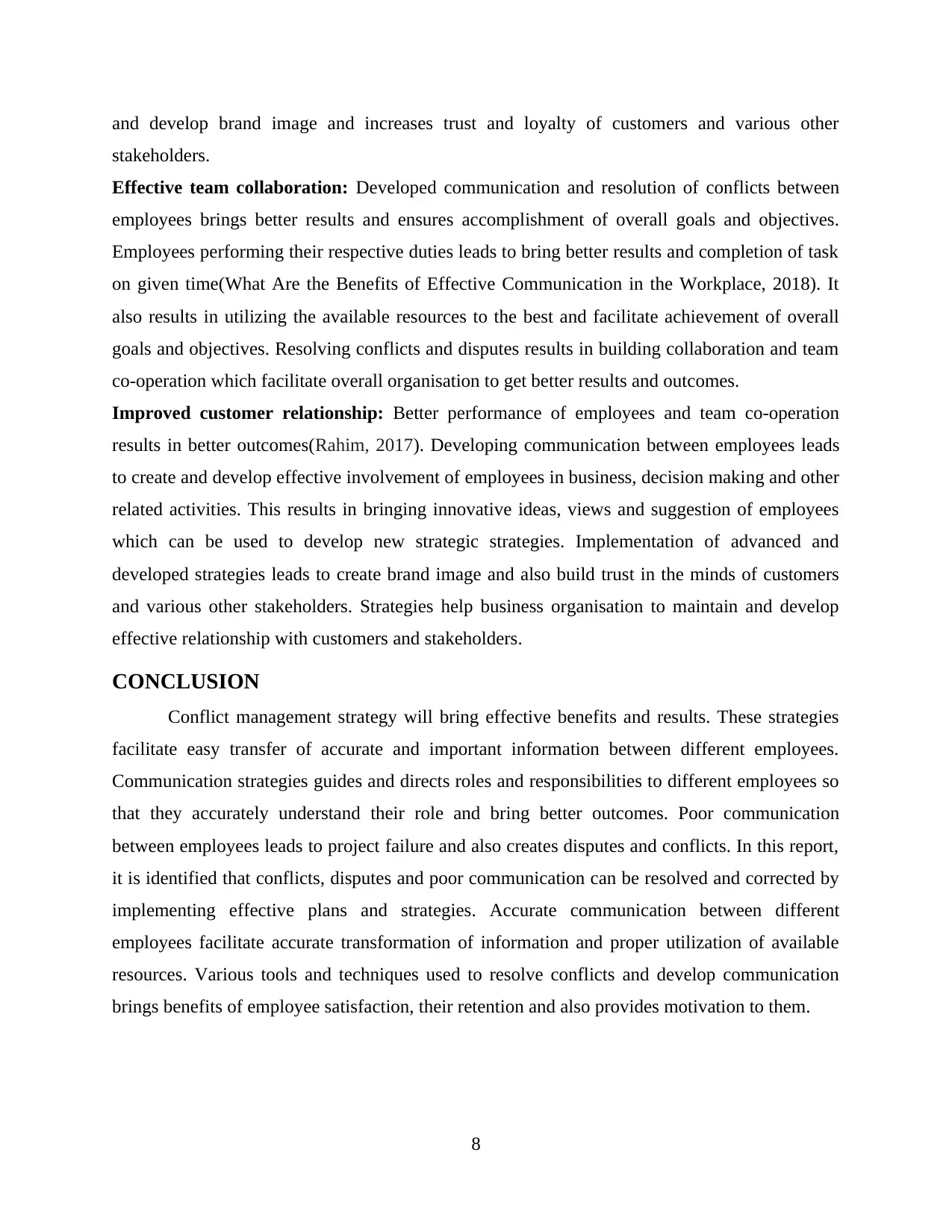
and develop brand image and increases trust and loyalty of customers and various other
stakeholders.
Effective team collaboration: Developed communication and resolution of conflicts between
employees brings better results and ensures accomplishment of overall goals and objectives.
Employees performing their respective duties leads to bring better results and completion of task
on given time(What Are the Benefits of Effective Communication in the Workplace, 2018). It
also results in utilizing the available resources to the best and facilitate achievement of overall
goals and objectives. Resolving conflicts and disputes results in building collaboration and team
co-operation which facilitate overall organisation to get better results and outcomes.
Improved customer relationship: Better performance of employees and team co-operation
results in better outcomes(Rahim, 2017). Developing communication between employees leads
to create and develop effective involvement of employees in business, decision making and other
related activities. This results in bringing innovative ideas, views and suggestion of employees
which can be used to develop new strategic strategies. Implementation of advanced and
developed strategies leads to create brand image and also build trust in the minds of customers
and various other stakeholders. Strategies help business organisation to maintain and develop
effective relationship with customers and stakeholders.
CONCLUSION
Conflict management strategy will bring effective benefits and results. These strategies
facilitate easy transfer of accurate and important information between different employees.
Communication strategies guides and directs roles and responsibilities to different employees so
that they accurately understand their role and bring better outcomes. Poor communication
between employees leads to project failure and also creates disputes and conflicts. In this report,
it is identified that conflicts, disputes and poor communication can be resolved and corrected by
implementing effective plans and strategies. Accurate communication between different
employees facilitate accurate transformation of information and proper utilization of available
resources. Various tools and techniques used to resolve conflicts and develop communication
brings benefits of employee satisfaction, their retention and also provides motivation to them.
8
stakeholders.
Effective team collaboration: Developed communication and resolution of conflicts between
employees brings better results and ensures accomplishment of overall goals and objectives.
Employees performing their respective duties leads to bring better results and completion of task
on given time(What Are the Benefits of Effective Communication in the Workplace, 2018). It
also results in utilizing the available resources to the best and facilitate achievement of overall
goals and objectives. Resolving conflicts and disputes results in building collaboration and team
co-operation which facilitate overall organisation to get better results and outcomes.
Improved customer relationship: Better performance of employees and team co-operation
results in better outcomes(Rahim, 2017). Developing communication between employees leads
to create and develop effective involvement of employees in business, decision making and other
related activities. This results in bringing innovative ideas, views and suggestion of employees
which can be used to develop new strategic strategies. Implementation of advanced and
developed strategies leads to create brand image and also build trust in the minds of customers
and various other stakeholders. Strategies help business organisation to maintain and develop
effective relationship with customers and stakeholders.
CONCLUSION
Conflict management strategy will bring effective benefits and results. These strategies
facilitate easy transfer of accurate and important information between different employees.
Communication strategies guides and directs roles and responsibilities to different employees so
that they accurately understand their role and bring better outcomes. Poor communication
between employees leads to project failure and also creates disputes and conflicts. In this report,
it is identified that conflicts, disputes and poor communication can be resolved and corrected by
implementing effective plans and strategies. Accurate communication between different
employees facilitate accurate transformation of information and proper utilization of available
resources. Various tools and techniques used to resolve conflicts and develop communication
brings benefits of employee satisfaction, their retention and also provides motivation to them.
8
Paraphrase This Document
Need a fresh take? Get an instant paraphrase of this document with our AI Paraphraser
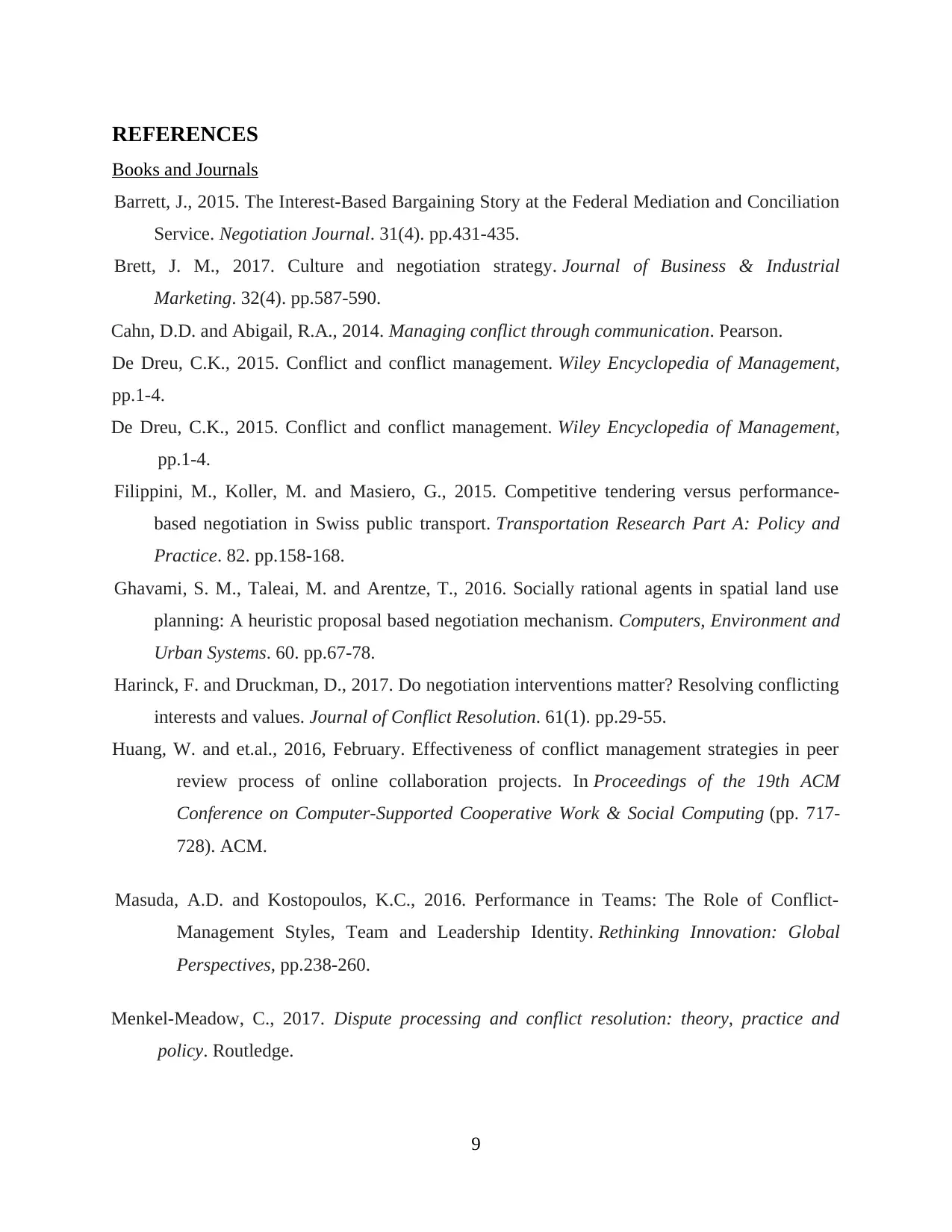
REFERENCES
Books and Journals
Barrett, J., 2015. The Interest‐Based Bargaining Story at the Federal Mediation and Conciliation
Service. Negotiation Journal. 31(4). pp.431-435.
Brett, J. M., 2017. Culture and negotiation strategy. Journal of Business & Industrial
Marketing. 32(4). pp.587-590.
Cahn, D.D. and Abigail, R.A., 2014. Managing conflict through communication. Pearson.
De Dreu, C.K., 2015. Conflict and conflict management. Wiley Encyclopedia of Management,
pp.1-4.
De Dreu, C.K., 2015. Conflict and conflict management. Wiley Encyclopedia of Management,
pp.1-4.
Filippini, M., Koller, M. and Masiero, G., 2015. Competitive tendering versus performance-
based negotiation in Swiss public transport. Transportation Research Part A: Policy and
Practice. 82. pp.158-168.
Ghavami, S. M., Taleai, M. and Arentze, T., 2016. Socially rational agents in spatial land use
planning: A heuristic proposal based negotiation mechanism. Computers, Environment and
Urban Systems. 60. pp.67-78.
Harinck, F. and Druckman, D., 2017. Do negotiation interventions matter? Resolving conflicting
interests and values. Journal of Conflict Resolution. 61(1). pp.29-55.
Huang, W. and et.al., 2016, February. Effectiveness of conflict management strategies in peer
review process of online collaboration projects. In Proceedings of the 19th ACM
Conference on Computer-Supported Cooperative Work & Social Computing (pp. 717-
728). ACM.
Masuda, A.D. and Kostopoulos, K.C., 2016. Performance in Teams: The Role of Conflict-
Management Styles, Team and Leadership Identity. Rethinking Innovation: Global
Perspectives, pp.238-260.
Menkel-Meadow, C., 2017. Dispute processing and conflict resolution: theory, practice and
policy. Routledge.
9
Books and Journals
Barrett, J., 2015. The Interest‐Based Bargaining Story at the Federal Mediation and Conciliation
Service. Negotiation Journal. 31(4). pp.431-435.
Brett, J. M., 2017. Culture and negotiation strategy. Journal of Business & Industrial
Marketing. 32(4). pp.587-590.
Cahn, D.D. and Abigail, R.A., 2014. Managing conflict through communication. Pearson.
De Dreu, C.K., 2015. Conflict and conflict management. Wiley Encyclopedia of Management,
pp.1-4.
De Dreu, C.K., 2015. Conflict and conflict management. Wiley Encyclopedia of Management,
pp.1-4.
Filippini, M., Koller, M. and Masiero, G., 2015. Competitive tendering versus performance-
based negotiation in Swiss public transport. Transportation Research Part A: Policy and
Practice. 82. pp.158-168.
Ghavami, S. M., Taleai, M. and Arentze, T., 2016. Socially rational agents in spatial land use
planning: A heuristic proposal based negotiation mechanism. Computers, Environment and
Urban Systems. 60. pp.67-78.
Harinck, F. and Druckman, D., 2017. Do negotiation interventions matter? Resolving conflicting
interests and values. Journal of Conflict Resolution. 61(1). pp.29-55.
Huang, W. and et.al., 2016, February. Effectiveness of conflict management strategies in peer
review process of online collaboration projects. In Proceedings of the 19th ACM
Conference on Computer-Supported Cooperative Work & Social Computing (pp. 717-
728). ACM.
Masuda, A.D. and Kostopoulos, K.C., 2016. Performance in Teams: The Role of Conflict-
Management Styles, Team and Leadership Identity. Rethinking Innovation: Global
Perspectives, pp.238-260.
Menkel-Meadow, C., 2017. Dispute processing and conflict resolution: theory, practice and
policy. Routledge.
9
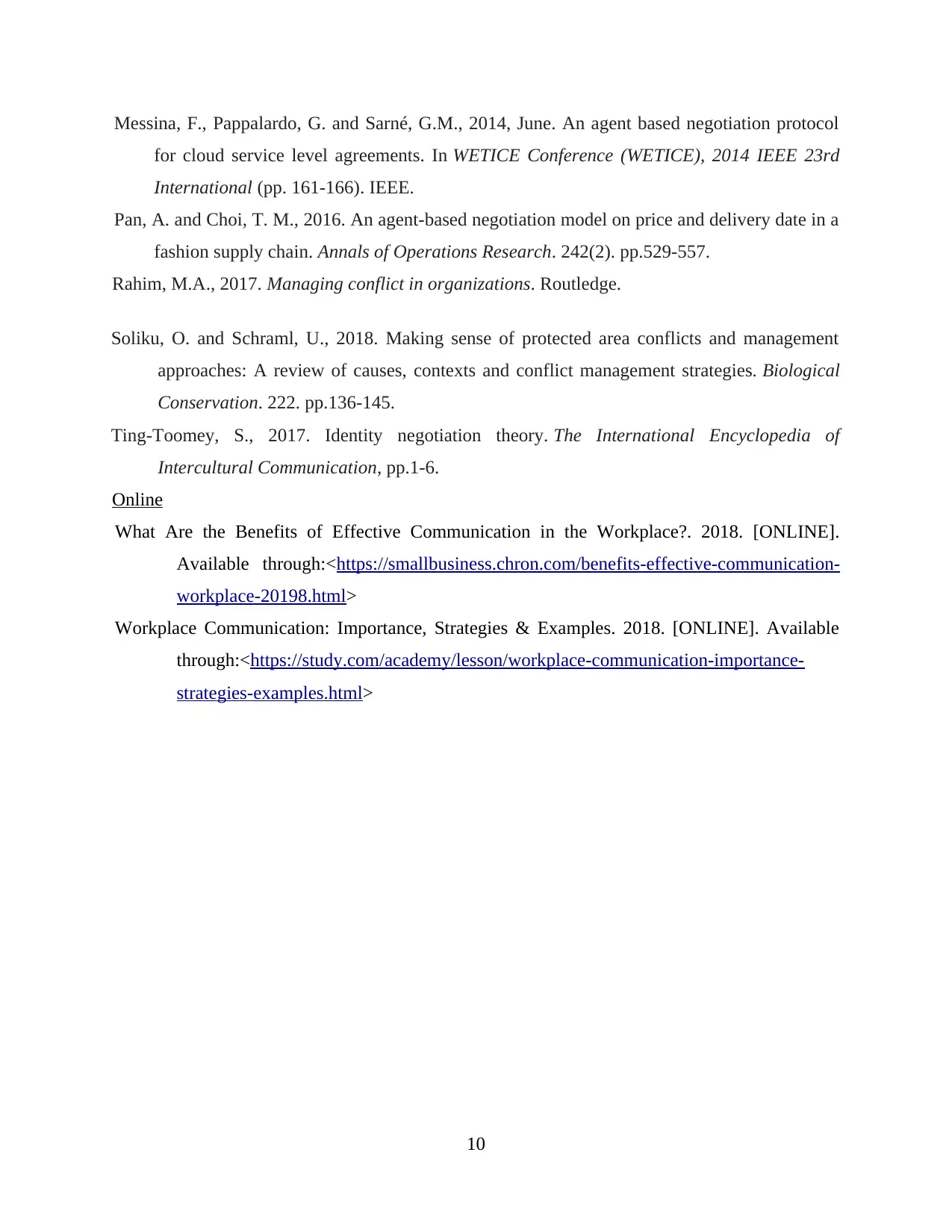
Messina, F., Pappalardo, G. and Sarné, G.M., 2014, June. An agent based negotiation protocol
for cloud service level agreements. In WETICE Conference (WETICE), 2014 IEEE 23rd
International (pp. 161-166). IEEE.
Pan, A. and Choi, T. M., 2016. An agent-based negotiation model on price and delivery date in a
fashion supply chain. Annals of Operations Research. 242(2). pp.529-557.
Rahim, M.A., 2017. Managing conflict in organizations. Routledge.
Soliku, O. and Schraml, U., 2018. Making sense of protected area conflicts and management
approaches: A review of causes, contexts and conflict management strategies. Biological
Conservation. 222. pp.136-145.
Ting‐Toomey, S., 2017. Identity negotiation theory. The International Encyclopedia of
Intercultural Communication, pp.1-6.
Online
What Are the Benefits of Effective Communication in the Workplace?. 2018. [ONLINE].
Available through:<https://smallbusiness.chron.com/benefits-effective-communication-
workplace-20198.html>
Workplace Communication: Importance, Strategies & Examples. 2018. [ONLINE]. Available
through:<https://study.com/academy/lesson/workplace-communication-importance-
strategies-examples.html>
10
for cloud service level agreements. In WETICE Conference (WETICE), 2014 IEEE 23rd
International (pp. 161-166). IEEE.
Pan, A. and Choi, T. M., 2016. An agent-based negotiation model on price and delivery date in a
fashion supply chain. Annals of Operations Research. 242(2). pp.529-557.
Rahim, M.A., 2017. Managing conflict in organizations. Routledge.
Soliku, O. and Schraml, U., 2018. Making sense of protected area conflicts and management
approaches: A review of causes, contexts and conflict management strategies. Biological
Conservation. 222. pp.136-145.
Ting‐Toomey, S., 2017. Identity negotiation theory. The International Encyclopedia of
Intercultural Communication, pp.1-6.
Online
What Are the Benefits of Effective Communication in the Workplace?. 2018. [ONLINE].
Available through:<https://smallbusiness.chron.com/benefits-effective-communication-
workplace-20198.html>
Workplace Communication: Importance, Strategies & Examples. 2018. [ONLINE]. Available
through:<https://study.com/academy/lesson/workplace-communication-importance-
strategies-examples.html>
10
⊘ This is a preview!⊘
Do you want full access?
Subscribe today to unlock all pages.

Trusted by 1+ million students worldwide
1 out of 12
Related Documents
Your All-in-One AI-Powered Toolkit for Academic Success.
+13062052269
info@desklib.com
Available 24*7 on WhatsApp / Email
![[object Object]](/_next/static/media/star-bottom.7253800d.svg)
Unlock your academic potential
Copyright © 2020–2025 A2Z Services. All Rights Reserved. Developed and managed by ZUCOL.





